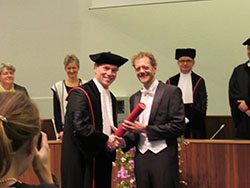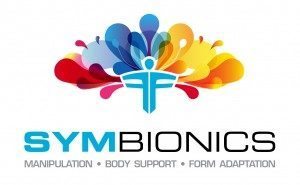On December 5th, Arjen Bergsma defended his dissertation titled: “The upper limb in neuromuscular disorders – From basic function to daily life performance”. [1] Our arms are important in carrying out daily activities. A muscular disease can limit the arm function, so that people are no longer able to carry out their daily activities in the way they want. Arjen and his colleagues studied the problems and limitations of people with different types of muscle diseases in daily life, and they used several instruments to measure this. While several instruments are available to study basic function and people’s capacity to perform activities, little is known about performance in daily life. In previous studies, only the capacity of people to do certain activities has been evaluated in laboratory settings. It is, however, very well possible that people perform different in their daily life compared to a situation where they are observed in a laboratory setting. The use of accelerometers has been proposed to get insight in how active people use the arms during the day. In Nijmegen, MOX accelerometers were used to evaluate the feasibility of determining the amount of arm activity in children with Duchenne Muscular Dystrophy and with Mitochondrial Disease [2] during the day. In those studies, participants wore MOX sensors at the upper leg, upper arm, lower arm and chest during a few days. The average amount of counts per hour and the maximal intensity were calculated. The feasibility of using the sensors to get insight in daily life performance was demonstrated. The use of accelerometers is considered to be useful to evaluate the effect of training interventions and to evaluate how effective assistive devices like arm supports are being used in daily life. Information about the amount of arm activity may also be useful feedback for patients themselves, to get insight in how active they are with the arms during the day. In current studies, we used a research oriented user interface for the MOX sensors. For clinical implementation, a more user friendly interface is recommended.
Author: Dr. Ir. Arjen Bergsma

[1] Bergsma, A. The upper limb in neuromuscular disorders – From basic function to daily life performance, PhD thesis, Radboudumc Nijmegen, 2016
[2] Koene, S. et al., Domains of daily physical activity in children with mitochondrial disease: a 3D accelerometery approach, Journal of Inherited Metabolic Disease, accepted
This research is carried out as part of the McArm project. http://mcarm.eu
Continued arm activity monitoring developments are carried out in the Symbionics project.

